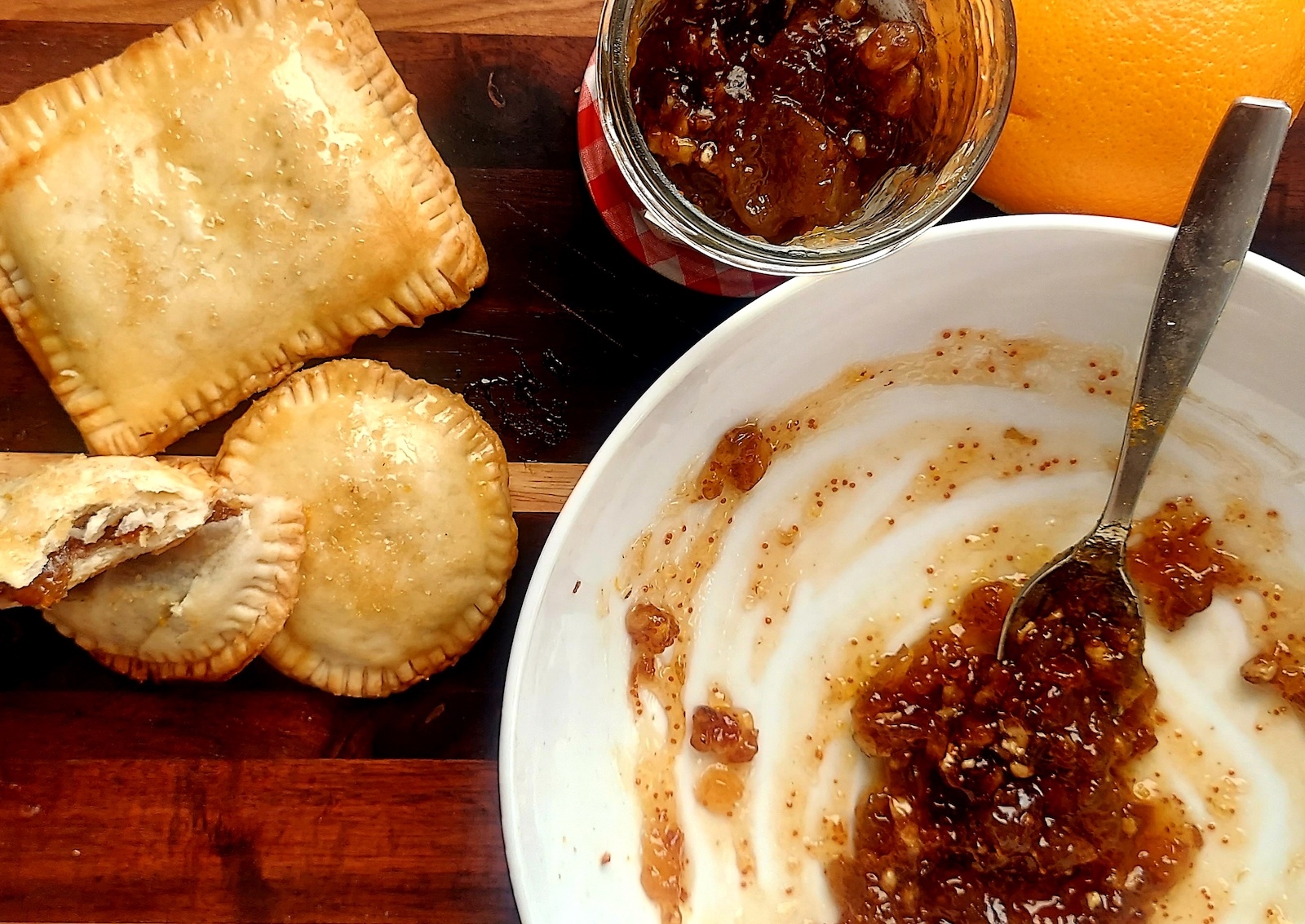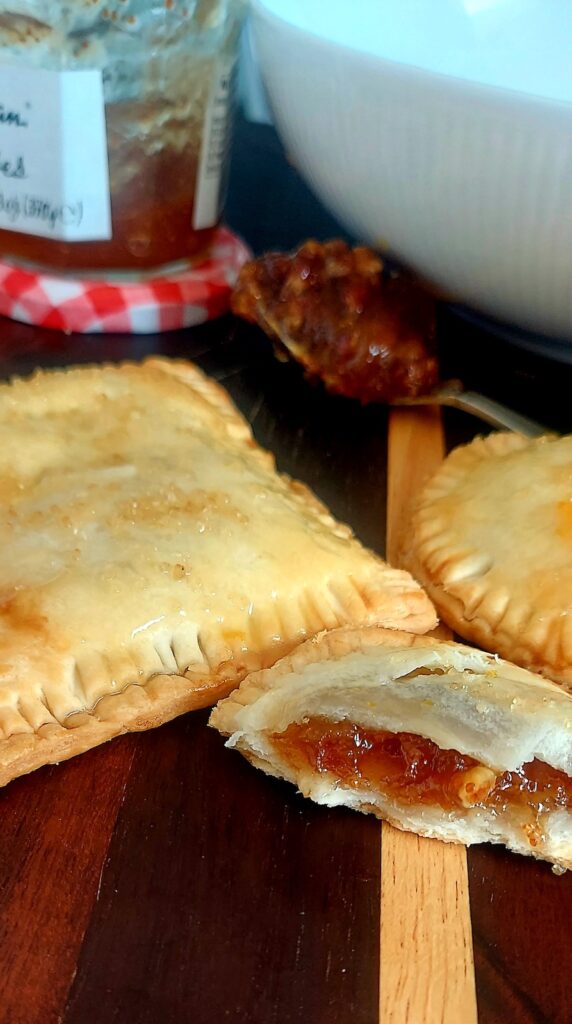Fig jam hand pies for the hesitant host

Every host has a cautionary tale. Mine starts with me brushing cornmeal onto a batch of English muffins at 4 a.m. and ends with me swearing off brunch for at least six years. I was 21, barely old enough to buy the champagne for mimosas, but somehow old enough to think I could pull off homemade biscuits, jam, cinnamon rolls and quiche for twelve.
I had just started my MFA program and moved into a former seminary that had been converted into student housing. “Formerly classrooms or dorm rooms?” I’d asked when touring. It was hard to tell — each unit had the same gray, featureless quality that made you feel like you might still be in trouble for something. The building sat on a slope; one direction led to campus by way of a hibachi joint whose owner always slipped me extra tubs of yum yum sauce, and the other led down toward a grocery store that was technically walkable, if you didn’t mind braving the highway ramp.
Life was good. I liked my classes, I had made a few friends and I was dating someone who worked at the campus hospital — close enough to hear the sirens, but not see the building. And like many women before me who reach a small, comfortable pocket of social success, I thought, I’m going to have some people over.
After some informal polling, it became clear that dinner was a logistical impossibility: too many night classes, too many part-time jobs, and (in a liberal arts program cliche) at least one person was dating a married faculty member who couldn’t contrive a post-sunset excuse to leave the house.
So, brunch it was.
In retrospect, this was my first real hosting gig. I’d had people over in college, but those gatherings had a kind of beautiful chaos to them — less expectations, diffused by more group effort. (“You bring the chips, I’ll bring the ice.”) This felt different. Adult, almost.
Having grown up in a deeply evangelical community where strident gender roles managed to scrub the fun out of almost everything, I’d never been particularly invested in looking domestic, per se. What I wanted, I think, was to feel sophisticated. I mean, I was 21, reading Joan Didion and watching “Barefoot Contessa,” trying to learn how to be the kind of woman whose life appeared edited. Somewhere between “Auntie Mame” and Martha Stewart felt about right.
I was gathering a roomful of writers, after all. Maybe this could be the start of something — a recurring salon, a tradition, a place where people could nibble pastries and say bright, approving things about me. “A little zany,” they’d say, a word woefully underapplied these days. “But she makes a great quiche.”
The planning began the way all great overcommitments do: with a library card.
Want more great food writing and recipes? Sign up for Salon’s free food newsletter, The Bite.
The Wi-Fi in my building was spotty at best, so I made the campus library my office, spreading out back issues of “Martha Stewart Living” and stacks of cookbooks across a long wooden table. I studied the pages like scripture — cross-referencing crust ratios, comparing jam methods, building a menu as though I were prepping for an exam. The smell of dust and toner mixed with the butter-fat perfume of whatever phantom feast I was imagining.
Back at the seminary apartment, I rearranged my thrift-store furniture, testing angles and proximity, trying to calculate how twelve adults might sit without anyone having to balance a plate on their knees. Eventually, I borrowed a folding card table and a few chairs from the student center, the kind that squeal in protest when you open them, and draped everything in mismatched linens that hinted, I hoped, at intentionality.
The menu came together like a dare to myself: homemade English muffins, individually griddled and dusted in cornmeal; my first pie crust for a quiche; cinnamon rolls with cream-cheese icing; two jams, strawberry and blackberry; a sheet pan of granola; six vegan muffins for the dairy-averse; fruit salad. I flirted briefly with making yogurt in my rice cooker before deciding to preserve a shred of sanity, only to immediately sacrifice it again by adding biscuits and sausage gravy.
It was pre-dawn and I was griddling English muffins because I had misread my notes and forgotten there was another rise. The galley-style kitchen had two burners that only sometimes worked and was a wreck. Every surface was sticky or dusted in flour, or both. My one good spatula had gone missing under a tea towel stiff with dough.
I kept wondering when to clean the bathroom, before I showered for cleanliness or after I showered for alertness. Neither seemed like the right kind of logic for a person awake at this hour making muffins she didn’t need. The air smelled faintly like burnt cornmeal and panic.
For the sake of the story, I wish there had been some kind of small catastrophe—a house fire because I dozed off tending the oven, a meltdown from one of the married professors that sent the whole table into mild chaos, something dramatic to mark the occasion. But no. The brunch went off fine. People were complimentary about the food. I don’t remember how any of it tasted, or exactly what we talked about. I do remember collapsing onto my bed as soon as the last guest left, and eating the leftovers in a kind of stunned bliss for the next week. In the grand scheme of things, it was a success, but the effort involved scared me off hosting for years.
I’m sure I wasn’t alone in feeling that way. Hosting is one of those things that can always be deferred. You’re too busy. Your apartment is too small. You’re not sure anyone would actually want to come. For me, more than anything, it was anxiety whispering in my ear: Do you want to spend four days preparing for the chance that you’ll just embarrass yourself? Be real.
And so I cooked, but I didn’t host. I became the quiet architect behind family dinners, steering Thanksgiving over the finish line, tucking myself into someone else’s kitchen for the holidays. I became the dependable participant at potlucks, arriving with two or three dishes to ensure there was something good on the table. I became the one friends called when they needed a few extra dishes at a dinner party, hours before guests arrived. I was present, but invisible in the orchestration.
That’s beautiful in its own way, but this year, something started to shift. I found myself reaching for books like Priya Parker’s “The Art of Gathering,” “Family Meal” by Ferran Adrià, and the galley for Hetty Lui McKinnon’s upcoming “Linger.” I realized that while hosting is an action, hospitality is a virtue. It’s a quiet thing, a way of showing care that doesn’t announce itself but makes a space feel like it matters.
In an ever-fractured world, I felt almost a spiritual obligation to practice it. And that, of course, was going to take work.
Thanks to the pandemic and a move to a new city, I still often feel like the new kid at school — that is, if “school” was literally just everywhere around me. So, I decided to start small. A few weeks ago, I noticed I didn’t know several of my current sixth-floor neighbors amid all the moving in and out. After a little hesitation, I pulled out a couple of miniature greeting cards (one featuring a loaf of bread and a stick of butter holding hands, another embossed like a tin of sardines) and slipped them under their doors. I introduced myself and suggested, lightly, that it would be nice to have them over sometime for coffee and a pastry.
To my delight, both responded. And that’s where these fig hand pies come in.

(Ashlie Stevens ) Fig jam hand pies
Unlike my manic-pixie-dream brunch from my twenties, where I tried to make everything from scratch, these are the kind of pastries you can actually pull together when company is literally on the way. The crust is flaky and buttery, golden at the edges, and tender enough to yield with a satisfying snap when you bite in. The filling is jammy and rich, jarred fig jam brightened with chopped dates and an almost scandalous amount of orange zest, so every mouthful tastes like autumn sunlight and just a hint of mischief.
You can cut and press the filling into little rectangular pies with crimped edges, like a store-bought toaster pastry, or embrace simplicity with small circular hand pies, made with a biscuit or cookie cutter — or, in a pinch, a wide-mouthed glass or jar. After baking and cooling, each pie gets a brown sugar–orange glaze that hardens just enough to crack when you bite, a sprinkle of flaky Turbinado sugar, and, yes, more orange zest for that extra zing.
Of course, you can make your own pie crust and fig jam if you like (I like this recipe and this recipe, respectively, in that case). But the point of this recipe is to give you something warm, tender and bright, something that comes together fast and still feels indulgent; a pastry you can pull from the oven and serve with coffee or tea without overthinking it.
You don’t need to be heroic to make people feel welcome. Sometimes a flaky crust, a sticky-sweet filling, and a few zesty flecks of orange are enough to do the trick. That’s the kind of magic these little hand pies carry.
Here’s how to make them at home:
Ingredients
For the pies:
- 1 package (about 14 oz) pre-made pie crust, thawed
- 1/2 cup jarred fig jam
- 1/4 cup chopped Medjool dates
- Zest of 1 large orange (divided: half for filling, half for glaze)
- 1 egg, lightly beaten (for egg wash)
For the glaze:
- 1/2 cup powdered sugar
- 1 tablespoon brown sugar
- 1–2 tablespoons freshly squeezed orange juice
- 1 teaspoon finely grated orange zest
- 1 tablespoon Turbinado or coarse sugar, for sprinkling
Directions
- Preheat the oven: to 375°F (190°C). Line a baking sheet with parchment paper.
- Prepare the filling: In a small bowl, mix fig jam, chopped dates, and half the orange zest until well combined.
- Roll and cut the dough: On a lightly floured surface, roll out the pie crust to smooth edges. Cut into rectangles (roughly 3×4 inches) or circles using a cookie cutter, biscuit cutter, or wide-mouthed glass. You’ll need an even number so you can pair tops and bottoms.
- Assemble the pies: Place a small spoonful of filling (about 1–2 teaspoons) in the center of half the cut dough shapes. Brush edges lightly with beaten egg and top with the remaining dough shapes. Press edges to seal, crimping with a fork or your fingers. Brush the tops lightly with egg wash.
- Bake: Place pies on the prepared sheet and bake for 18–22 minutes, or until golden and slightly puffed. Let cool for 5–10 minutes on the baking sheet, then transfer to a wire rack.
- Glaze: In a small bowl, whisk powdered sugar with orange juice, brown sugar and zest until smooth. Drizzle over cooled pies and sprinkle with Turbinado sugar. Let glaze set for a few minutes before serving.
This story originally appeared in The Bite, my weekly food newsletter for Salon. If you enjoyed it and would like more essays, recipes, technique explainers and interviews sent straight to your inbox, subscribe here.
salon





